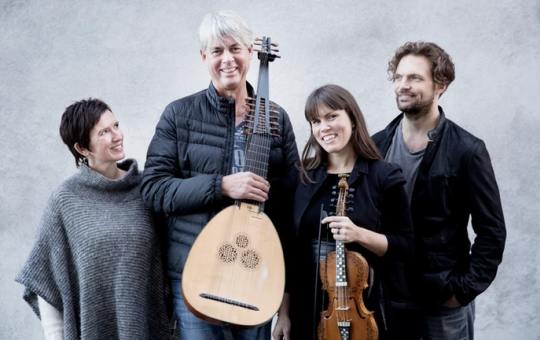|
Tidekverv (‘Timeturning’) is a lush, spare, and emotional project envisioned by Norwegian Hardanger fiddle player Benedicte Maurseth and vocalist Berit Opheim. They are joined on this recording by Norwegian musicians Rolf Lislevand (lute, electric guitar, and electric bass) and Håkon Mørch Stene (percussion, vibraphone, and slight and sensitive electronic accompaniment).
Thematically, Tidekverv is one piece in honor of the sun. Maurseth’s vision for the performance was rooted in the medieval ballad ‘Draumkvedet,’ which recounts the passage of Olav Åsteson as he falls asleep on Christmas Eve and his awakening on the twelfth day of Christmas. Åsteson’s slumber is marked by a trip through Hell, with glimpses of Heaven. Åsteson’s dream experiences are recounted to his church congregation, who in true allegorical fashion are encouraged to act well in order to avoid fire and brimstone. ‘Draumkvedet’ (‘Dream Poem’) has taken on ritual significance (recounting a trip into the afterlife connotes reincarnation), and it is performed in Norway on the thirteenth day of Christmas.
A passage through time is key to Tidekverv, whose rhythm is punctuated by the four days of the year most associated with the sun: the spring equinox, the summer solstice, the autumnal equinox, and the winter solstice. In this musical journey, the sun ‘turns’ on the solstice days – the longest and shortest days of the year, heralding ‘turns’ from and towards the light and the changing seasons. Through the year and the lengthening and dwindling of days, the sun itself is reincarnated and returns to bring warmth and heat after the cold and desolation of winter. Life, death, rebirth: the sun embodies an ancient circle of human concerns.
Tidekverv presents both texts and instrumentals. Maurseth’s inspiration from ‘Draumkvedet’ led to the participation of two noted Norwegian authors, Bergsveinn Birgisson and Erlend O. Nødtvedt, in the project. The texts mirror the form of writing in the medieval poem: two- and four-line verse, following a ballad form with a refrain. Birgisson wrote the lyrics for the “Winter” and “Spring” tracks, collaborating with Nødtvedt on “Summer” and “Autumn.” The results are poetically luscious.
Right from the start, when Opheim sings in “Winter”: “In the dark night of my soul/I thought upon the matter:/Where did I lose hope along the way,/will I find it again?/- It’s good the sun still lingers on/no matter what you do believe,” we encounter modern reflection resonating with ancient connections. The ghost of ‘Draumkvedet’ stalks: “I fell asleep in the thick of it/Like a ghost in the dark I go…,” the low light of winter providing some hope that the sun “lingers on.”
A third of the way into the tune, Lislevand’s lute enters, and the soundscape opens up with a touch of the baroque and Middle-Eastern tonality. Maurseth’s Hardanger fiddle adds another layer, the instrumentation reflective and searching, until Opheim’s and Maurseth’s voices join together to close out the sung text.
Musical interludes follow – “Tidekverv II/Timeturning II” begins with Stene’s vibraphone, the effect slightly Reichian, and there is a dance with Lislevand’s lute as the female vocals play around the musical structure. “Varjamdogn/Equinox” has a glistening, ambient start, through which Maurseth’s fiddle playing emerges as if penetrating the thin ice on a lake.
Thence to “Var/Spring”: “Slowly, calmly comes God’s hand/and lifts the sun above the land/-The light comes without mercy to dark corners-.“ The arrangement amongst the musicians leaves room for Stene’s percussion work, an insistent, throbbing pulse under the lyrics and the gliding of Maurseth’s fiddle. The effect is not only of new life pulsating, but also a sonic poem commenting on the text’s “singing heart.”
The ”Summer Soltice-Gangar” is more sprightly, built upon shaken tambourine and knocking percussion. Gradually, Maurseth and Lislevand meet in a sun-dappled dance. This interlude gives way to “Sommar/Summer,” and imagery that combines the human and animal worlds. The song has a gorgeous melody, redolent of medieval music, once more underpinned by Lislevand’s strong lute playing. Maurseth and Opheim sing together on this track, as well: “A dancing troupe of man and beast/is gathered by the way/The apple from the ancient tree/forgotten at the height of day.” One feels privy to a hidden festival of which we are a part, but that we observe apart from nature. The distinction between the two states falls away in musical trance.
“Tidekverv I/Timeturning I” rings a wistful change, the ensemble indicating a change felt in the wind. And so to “Haust/Autumn”: “I’ve made brawn and I’ve boiled stock/- the primestaff shows it’s Michaelmas-tide/in my glass floats a memory of summer’s height/-light and dark agree like groom and bride-.“ It’s that last, evocative line: “-light and dark agree like groom and bride-“ that brings in the harvest, the growing shadow of the darkening season shaking hands with prior times as the months trek inexorably to winter.
To close out Tidekverv, we are treated to a short Maurseth solo composition, “Den 5. Gorrlause”: stately, swooping, and dissolving into silence. Hidden track ten sounds at first like a digital radio signal, but then takes on the character of a lone bird, disappearing into the sky.
Maurseth, Opheim, Lislevand, and Stene deliver a fulfilling album that offers the listener much: folk forms dipped into classical settings; the resuscitation of a medieval poetic format; and moments that warmly bridge the ambient and experimental. There is a Romanian expression that translates roughly to “a sun with teeth” – days when how the weather appears does not feel quite the same outside. Listening to Tidekverv in a time of pandemic, when the summer approaches and we long to feel the caress of the sun on our skin, is reassuring. After the long, dark night, the sun’s promise will still be there for us. Someday. – Lee Blackstone
Find the artist online.
Photo: Paal Audestad
|
